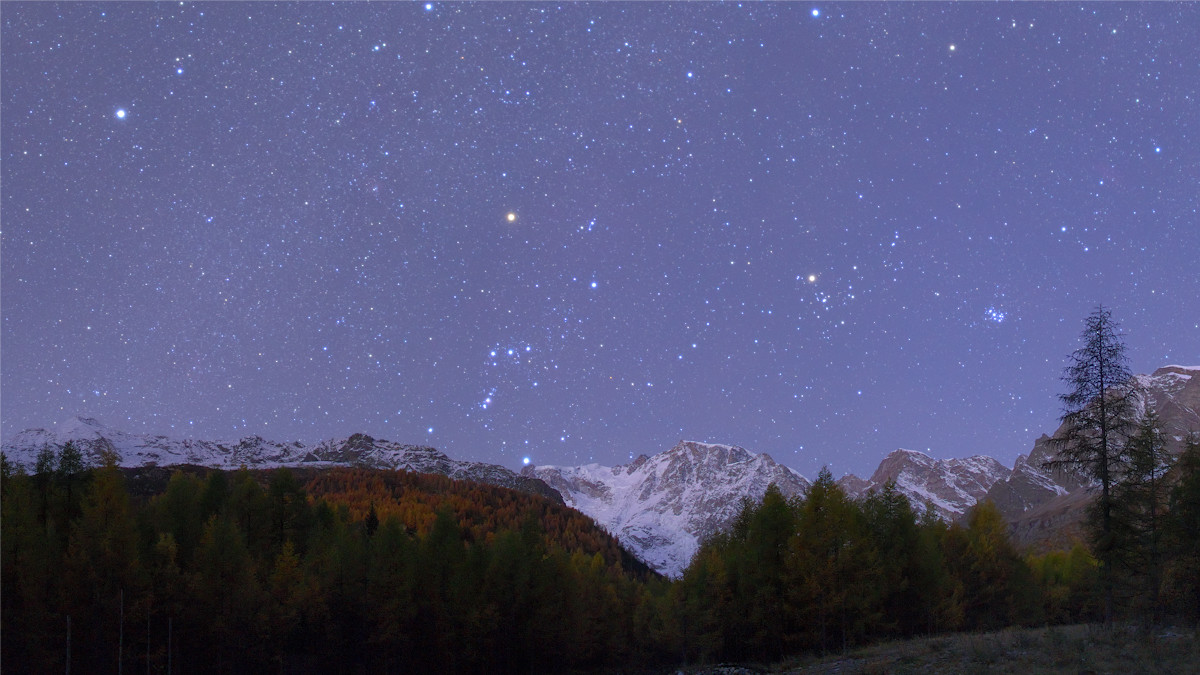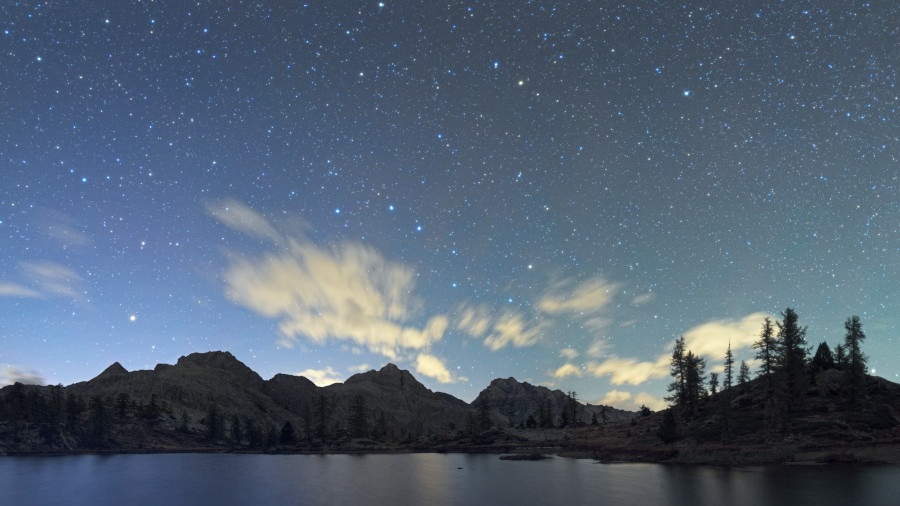Stardust and eternity – 3.3.2
Circumpolar and seasonal constellations
Among the 6000 stars visible to the naked eye at ideal locations, we often recognize particular groups of stars situated in the same region of the sky, forming particular patterns or “asterisms” – commonly known as constellations. Nowadays, the astronomical community acknowledges 88 constellations, the majority of which are visible from the northern hemisphere of our planet. Although stars belonging to the same constellation may be very far from one another, these stellar patterns are popularly known for historical reasons and frequently bear mythological names, based on classical Greek legends, such as Andromeda, Gemini, Orion, and so on. Constellations have always been useful tools for sky orientation. For instance, the star Polaris, or “Little Dipper” – a moderately bright star at the tip of the handle of the Ursa Minor constellation – has been used by navigators since ancient times to determine the direction of north. Indeed, the Earth’s axis points almost exactly to Polaris; all other stars, due to Earth’s rotation, appear to circle counterclockwise around this “fixed” star at a speed of about 15 degrees per hour, completing one complete revolution (or 360 degrees) in one day.
Since the altitude of Polaris above the horizon is equal to the observer’s latitude, some of the stars that lie close to it – and thus their constellations – never descend below the horizon as they make their apparent paths around it. These “circumpolar constellations” are thus visible all year above the horizon. For example, the well-known Big and Little Dipper constellations (Ursa Major and Ursa Minor), or the W-shaped Cassiopeia are always visible in any season and every night at European latitudes, whereas at the North Pole all stars are necessarily circumpolar. Conversely, there are no circumpolar constellations at the Earth’s equator. Moreover, constellations observed by stargazers at southern latitudesm, near the South Pole, never rise above the horizon in the northern hemisphere, so that they are always invisible to us.
Differently from circumpolar constellations, the so-called “seasonal constellations” are visible at night only in particular seasons. Indeed, since our planet changes position as it orbits around the Sun throughout the year, we continuously see the stars of our galaxy from a different perspective – according to the patterns of stars on the night side of the Earth, opposite to the Sun. For example, given that the Sun’s apparent path in the northern hemisphere transits through three of the twelve “zodiacal constellations” of western astrology during winter – Sagittarius, Capricorn and Aquarius – these constellations are not visible in the winter night sky. They become instead visible during summer, when our field of vision has shifted 180 degrees.


Further resources
Links below will redirect you to external websites. In accordance with the European data protection declarations, we would like to point out that by clicking on these links you may send data to external providers. We cannot prevent that.
Images
![]() Gemini, Orion and Taurus over a cascade (E.Balboni, cosmoedintorni.org)
Gemini, Orion and Taurus over a cascade (E.Balboni, cosmoedintorni.org)
![]() The Big and Little dippers over Gran Seru (E.Balboni, cosmoedintorni.org)
The Big and Little dippers over Gran Seru (E.Balboni, cosmoedintorni.org)
![]() Auriga, Taurus, Pleiads and La Meja (E.Balboni, cosmoedintorni.org)
Auriga, Taurus, Pleiads and La Meja (E.Balboni, cosmoedintorni.org)
Videos
![]() Types of Constellations (Learn the Sky)
Types of Constellations (Learn the Sky)
![]() Introductory Astronomy: Seasonal Changes in Star Patterns
Introductory Astronomy: Seasonal Changes in Star Patterns
![]() What Are Constellations? (Astronomic)
What Are Constellations? (Astronomic)
On line resources
![]() Northern circumpolar constellations (C.W.Perry school)
Northern circumpolar constellations (C.W.Perry school)
![]() Northern circumpolar constellations (Windows to the Universe)
Northern circumpolar constellations (Windows to the Universe)
Further readings
![]() The Constellation Observing Atlas (Grant Privett, Kevin Jones)
The Constellation Observing Atlas (Grant Privett, Kevin Jones)
![]() The Stars: A New Way to See Them (H. A. Rey)
The Stars: A New Way to See Them (H. A. Rey)
![]() Constellations: The Stars and Stories (Chris Sasaki)
Constellations: The Stars and Stories (Chris Sasaki)
![]() Stories in the Stars: An Atlas of Constellations (Susanna Hislop)
Stories in the Stars: An Atlas of Constellations (Susanna Hislop)
![]() A Walk Through the Heavens A Guide to Stars and Constellations and Their Legends (M. Heifetz, W.Tirion)
A Walk Through the Heavens A Guide to Stars and Constellations and Their Legends (M. Heifetz, W.Tirion)
![]() Star Tales (Ian Ridpath)
Star Tales (Ian Ridpath)
Teaching Material
![]() 22 Stellar activities to teach about stars
22 Stellar activities to teach about stars
For Kids
![]() Constellations for Kids: Learn about the constellations, their names,how to find them
Constellations for Kids: Learn about the constellations, their names,how to find them
![]() Constellations: Connect the Dots in the Sky!
Constellations: Connect the Dots in the Sky!
![]() The Zodiac Constellations (Crash Course Kids)
The Zodiac Constellations (Crash Course Kids)
![]() Super Stars (Constellations) (Crash Course Kids)
Super Stars (Constellations) (Crash Course Kids)
![]() Constellation Location: Crash Course Kids
Constellation Location: Crash Course Kids
